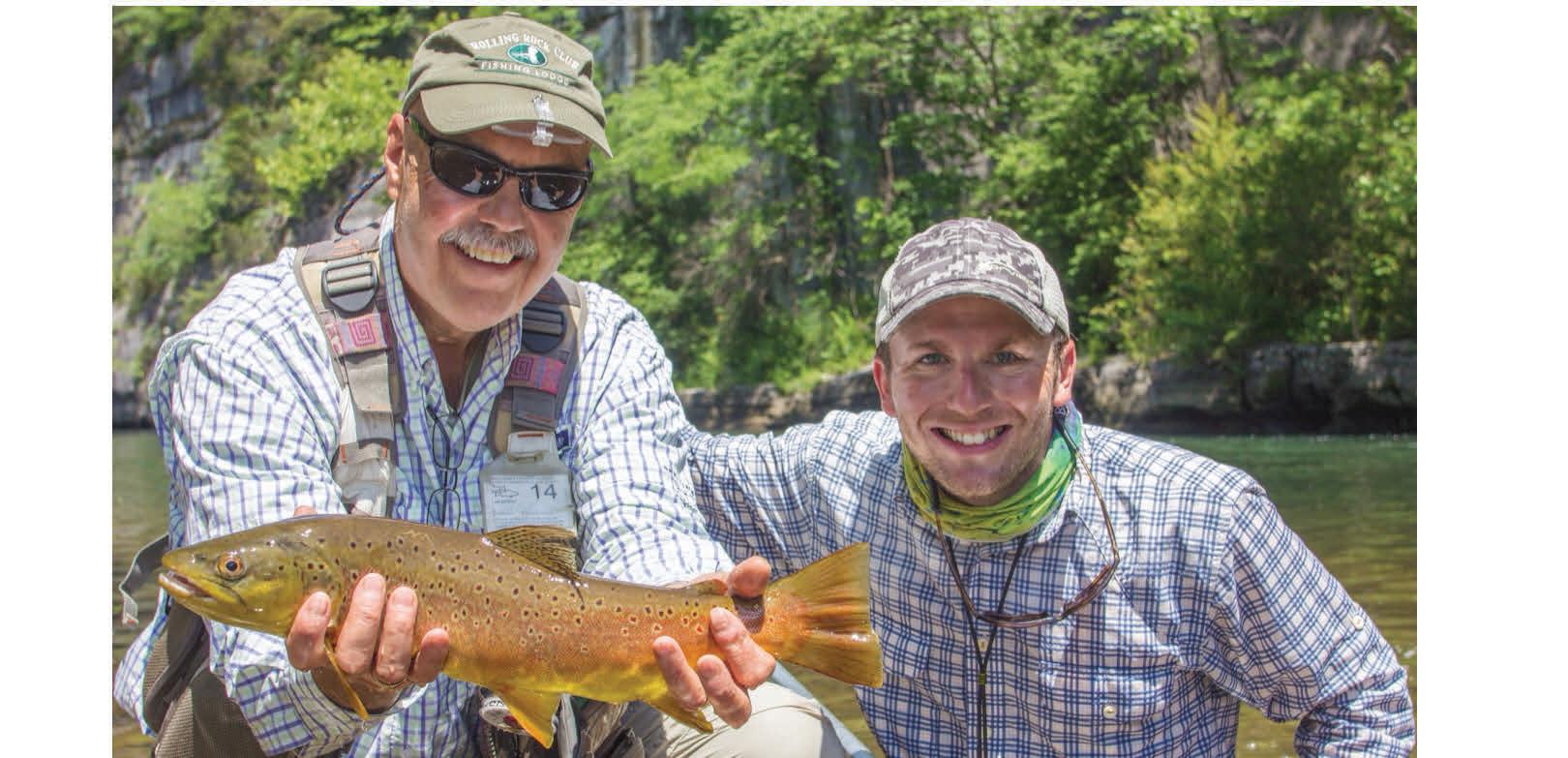

















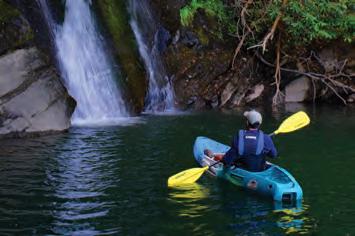

























Embarking on the open water is an exhilarating experience, flled with the promise of adventure and relaxation. Whether you’re a seasoned sailor or a weekend cruiser, safeguarding your vessel with proper insurance is not just a choice—it’s a necessity. Explore the reasons why every boat owner should prioritize boat insurance for a worry-free voyage.
The open water can be unpredictable, with unexpected storms, collisions, or other potential accidents. Boat insurance can give you fnancial protection if there is damage to your vessel, providing coverage for repairs or replacement.
Accidents on the water can result in damage to other boats, docks, or even injuries to passengers. Boat insurance offers liability coverage, which can pay for damages or injuries you’re liable for while boating, up to specifed limits, and lawsuit costs if you’re sued. This includes damage you cause to another watercraft or if someone on or near your boat is injured and you’re found to be legally responsible.
Unfortunately, boat theft and vandalism are realities that boat owners face. Boat insurance has comprehensive and collision coverage that can protect you against events outside of your control, including theft and vandalism.
Accidents on the water may lead to injuries for you or your passengers. Boat insurance offers a range of optional medical payments coverage limits, helping to cover medical expenses if you are in an accident or someone is hurt on your boat, regardless of fault.
If you fnanced the purchase of your boat, most lenders require insurance coverage to protect their investment. Having boat insurance not only fulflls these requirements but also gives you peace of mind knowing that your fnancial interests are safeguarded.


Some water municipalities and marinas may require proof of insurance for docking or accessing certain areas. Boat insurance allows you the fexibility to explore different destinations without worrying about entry restrictions.
Emergency towing and assistance
Progressive boat insurance can include optional Sign & Glide® On-Water Towing coverage. If your boat is disabled or breaks down on the water, Sign & Glide® pays for on-water towing, jump starts, soft un-groundings, and fuel delivery.
Wreckage removal
If your boat sinks, Progressive boat insurance will cover the cost of removing your boat from the water (if removal is legally required).
Investing in boat insurance is not just about protecting a valuable asset; it’s about safeguarding the memories, experiences, and joy that come with your on-water adventures. Don’t let unforeseen circumstances disrupt your journey—navigate with confdence, knowing that Progressive boat insurance has you covered. Ensure a smooth and worry-free voyage, because when it comes to your boat, peace of mind is the ultimate luxury.
Scan to get a quote in as little as 4 minutes
learn more.























Throughout chc year, the Florida KC)'S provide excclltnt billlish oppor1unitics.
Bycapt.QulnlynHaddon
Sailfish c.an be foulld year.round and are most reliably targeted in late autumn through the spring when they feast on ballyhoo at the reef.
Swordfishing is grc.1t any time ofthe year. as lcmgasM!3.lhcr accommodal('S!he l<>nsrnn l() the decpwa1cr JcdgcS. Tai:gcting them during tht:: day re<1uii:csdroppingabaitLothebottom.
�fariinfishi11gjsdoableduri11gsummer.butit$ certainlyJess thanreliable. 'Ihey a.-eoftenhooked as bycatch while fisltillg for the mahi or tuna on whichtheyarefeeding.
I recently had the pleasure of taking a trip solely targetingmarlinandswordfish.\Vehadtwo fishermen on board who were firs1 1liners with both.spl't'i<$. It wasintcro:,ting ,vatching them go 1hrough thebipolarswingsofbUlfishing. ·n1eywere

there LQ a$$i:.land learn, and I got lo watch them enjoy nnd suffer through thefull experience. Initially. there was opliini.sm as the su1\ rose a11d wedeployed ail elaboratetrolling spread. 1he setupmust haveseemedfantasticaltoanewcomer, with the giant lures.strange-looking teasers and lines everywhere. like we were captained by a coffoc fuclcdspider.Thedaywas )'Oung.1hcspread ,rasaworko(an,andthenc,,·bieshadnoreasonto doubt ourchances.
Frustrationsoo1lfollowed.Aswewerewtapping up marlin 1rollillg to head for the swordgrouods.

wepa.ss«1agorgeous weed linefull ofhma birds. It looked likeourbestchance... until the right rigger caught grnss. Upon• gentle rc1ricvc10dc.1rtheline,itpopf)OOthe rigger, foll1hroughthespreadam.lauempll-'<ll.Omate with the teaser al the worst time. We packed up inthemiddleof1hegiantflockof birdsthat mockedusforquitting.Ahh,disappointinent It was time co hii Lhe swordgrouncb and beginthecycleagain.Our nextelaboratesetup wo,dd drop to 1,500 feet.and the doe e)eS of optimismmadetheir nextappearance. 1hc dance belwccn doubt. lx)rcdom and forcedoprimismcontinued.a,,;ourfirs1bitedidn1l occuruntilafter4 p.m. It wasaheavyhit.a reelstopping, drag-pulling, set-up-the-harpoon type hit that had us giggling like children. El'eryone was re�1dy to t.1keon dutieswhen, JOO.feet from theweight, the rod tip popped up and everrone experiencedgut.wrenchingheartbreak.
On Lhc nc:ic1 drift, we hooked up again, and cvcrronequietlyheldtheirexcitement untilthetlsh hit the deck. l don't m.�d to cxplah\ the foe-ling in that Jlext moine11t, but with smiles and high fives a1J around > it was the 011e we wereall looking for. We tookhomesati.sfactio11.exhaustio11.andbigbags ofm<.".ll.
Hunting swimming unicorns is hands-down m)' favorite fishing. If youwant toexperiencethe emotional rollcrcoaS1cr of chasing the fish of a lifetime,givemeacallalSwce1 E'nul'Charters.
Capt, Quinl)'u Hmtdcm guides wit/1 Swed E'Nu/Clwrlers, Mnratliot1, Florida Keys. ww1�capt<1inqui11ly11.ccm1; <fi>captai11q11i11/y11; (504) 910�-12.
If you love the outdoors and dream of being in business for yourself, now is the time to choose a Coastal Angler or 111e Angler Magazine Franchise.


ESTABLISHEDBRAND • PROVEN SYSTEMS TRAINING &ONGOINGSUPPORT WORK FROMHOME • BEYOUR OWN BOSS
We have freshwater and saltwater Franchise territories available throughout the colmtry. Ask one of our specialists about franchise availability in your area.

You want AI Routing! Let TZ MAPS with AI Routing make route planning a snap. Don’t take our word for it. Scan here to see for yourself how easy it is!
It’s hot. Te lakes and reservoirs are covered with jet skis, wake boats and party barges full of sun seekers.
Dog days conditions can be tough for bass fshing, but fsh settle into patterns this time of year that can lead to productive days on the water.
Finding cooler water is the key to catching bass when the surface temperatures reach uncomfortable levels, and there are several ways to do this.
Go Deep: Te huge schools of fsh that concentrate on ofshore ledges and river channel bends at many of our large reservoirs have already been beaten into submission by every angler with sonar by this time of year. You might still be able to pick a few out of the school with deep crankbaits, drop-shots or footballhead jigs, but sometimes it’s worth fnding less obvious fsh to target.
Tere are other areas that hold fsh. Tat 30-footwide shell bed of the main channel might not be covered with bass, but there will be some fsh there if there’s some current, and these bass see much fewer lures and are more willing to bite this time of year. Search with a crankbait, wiggle a football-head on the bottom or drag a big Carolina rigged worm over the shells and see what happens.
Cool-Water Tribs: A tributary stream feeding cooler water into the lake attracts baitfsh and bass. Fish ofen stage on points where a feeder creek enters the main body. Eliminate water quickly with crankbaits or spinnerbaits to see if there’s anyone home before
slowing down with a jig or a worm.
By CAM Staf
Extend the Night Bite: Bass do a lot of their feeding at night this time of year, and anglers can take advantage of this by fshing the frst couple hours of daylight.
Tis pattern will also show you that not every fsh in the lake goes deep. Shallow rocks and grass edges hold bluegill, shad, crayfsh and all sorts of other tasty critters. Start on top at or before dawn with a walking bait or popper and cover as much water as you can before the sun gets up. Tis is not really a numbers game, and the bites will be scattered, but it’s a lot of fun when a big fsh blows up your lure.
Fish the Shade: When the sun gets high and hot, you’ll fnd fsh hunkered down in the shade. Docks, laydowns, overhanging trees or matted vegetation all provide the shade bass and the things they eat look for. Bank shade is also where you’ll fnd bream beds where bass like to feed.
Skip a wacky rig up as far up under a dock as you can get it. Drop a jig into that blowdown. Work a frog over matted grass or punch through it with a heavy Texas rig. Cover water and pick apart those shady areas. It’s a fun style of fshing that can also be productive under less-than-perfect conditions.
For more bass tips, go to coastalanglermag.com.




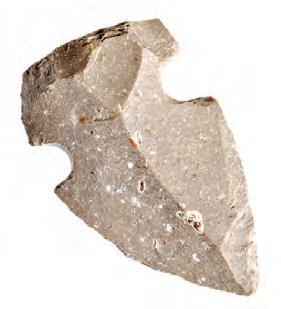




There is nothing quite like the thrill of a treasure hunt—exploring and embracing your sense of adventure in your quest for finding extraordinary masterpieces. You’re going to LOVE these hard-to-find items, especially with the big savings you’ll find here!













7 Hard-to-Find Collectibles in One Set!


























Here’s what the Treasure Hunt Collection includes: Commemorative Print of the highest denomination bill ever issued by the U.S. Mint—$100,000! Authentic early Native American stone arrowhead. 1957 $1 Silver Certificate in Very Fine condition, phased out by President John F. Kennedy’s final excutive order, on June 4, 1963. One-ounce pure copper bar featuring the design of the Morgan Silver Dollar. Iconic Buffalo Nickel featuring James Earl Fraser’s classic design, dated from 1913-1938. 1943 Lincoln Steel Cent, an authentic piece of World War II history. Tenth-Ounce Silver Incuse Indian Round featuring the incuse Indian design created by Bela Pratt for the 1908 $2.50 Gold Indian coin.





















Get FREE SHIPPING when you buy two or more sets! Call right now, before they’re gone! Limit of 20 collections per customer. If you purchase one set you will receive a special shipping and handling rate. Treasure Hunt Collection ONLY $19.95

• Stone Arrowhead










TREASURE HUNT COLLECTION • 1934 $100,000 Gold Certificate Commemorative Print
• 1957 $1 Silver Certificate VF
• One-Ounce Morgan Copper Bar
• 1913-1938 Buffalo Nickel
• 1943 Lincoln Steel Cent
• Tenth-Ounce Silver Incuse Indian
Offer Code THS106-01 Please mention


By Mark Ambert
With summer weed line formation, mahi become a favorite target for the “run and gun” method. A good way to quickly scout if anyone’s home is a modifed version of the troll. I have observed and adopted this method used by professional captains for mahi.
Keep a couple of spinning rods rigged and ready with pitch baits that can be trolled. Te rig consists of a 7-foot medium-heavy spinning rod with a 6000-size spinning reel—preferably with a baitrunner setting.
If you’re not familiar with the baitrunner function, it is a free-spool setting that allows line to pull from the spool while the bail is engaged. When a fsh grabs your bait, it can take it without feeling resistance.
My favorite combo is a Penn Carnage III boat rod with a Shimano Tunnus reel. Spool up with 20-lb. mono and add a 40- or 50-lb., 4-foot fuorocarbon leader. Tie on a Gamakatsu 6/0 or 7/0 Octopus hook using a Palomar knot. Insert the hook under the chin of a fresh frozen, small- to medium-sized ballyhoo. Make sure the point of the hook exits directly between the eyes. I like a Squidnation Slammer 3-inch plastic chugger head
with the bait to produce more action.
Cast this behind the boat along a weed line while underway. Position it several yards past the last wakes from the prop wash, and slowly work the bait by twitching the rod tip while holding it above your head. Tis will cause the ballyhoo to skip like a feeing baitfsh. You can work two baits in this manner by staggering the distance. If nothing hits within a few minutes, move on.
Tis method is slower than traditional trolling, and it is deadly for locating feeding fsh on large, scattered weed patches. If you are using a baitrunner reel, allow the fsh to run a few seconds before setting the hook.
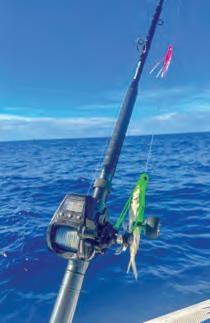
An alternate method that’s ideal for long straight weed lines or rips is a more traditional trolling setup. I use the Piscifun Saltfow ofshore rod and a Kraken electric reel with battery pack for this type of trolling.
Te Saltfow is 8-foot, 3-inch rod with a sof tip. It has a unique line guide setup that eliminates rod twist under a load. Te Kraken electric reel is new to me this year and has already paid dividends.

beneft when constantly retrieving lures to clear weeds or move locations. A traditional ballyhoo rig with a teaser and bait spring is my choice for medium-speed trolling. A good premade rig is the Mahi Chaser by Trolling Pro Tackle.
Once you get a hook-up, get some fresh squid, jigs or live baits in the water and hang on. Te Mahi show is about to get started!
Mark Ambert, IG @marksgonefshing_™






By Jackie Greene
This project started over 3 to 4 years ago as Jim Mabrey – former NC State TU Chair, Squeak Smith – recipient of 5 NC Governors awards and Former Chair of Resource Institute, Wes Waugh, Director, A Clean Wilson Creek and Shea Tuberty, Biology Dept. at App State and I sat down with property owner Carla Brinker, to discuss the bamboo and the potential damage it was causing to the campground and to the River. Carla and John Brinker, of Wilmington NC had recently purchased and renamed the former Killians Camp to Wilson Creek Preserve.
Getting these particular people together, most who had never met, was the easiest part of the entire project. These people are all very conservation minded and are or have been involved with Wilson Creek in one way or another for years. Covid was in its infancy and things quickly stalled. Besides, everyone knew that this was going to be a big undertaking and where to begin and what would or could be successful, we just wasn’t sure. So many things came into play.
Over the next couple of years Jim and a couple other campers experimented with possible scenarios that could be useful. Also, during that time the stand of Bamboo became bigger and more daunting. It had grown to a point where during flood stage the bamboo was so dense that it actually held back the river causing it to split into two sections to go around the bamboo patch. The top part of the river, closer to the main road dug a hole about 30 ft long and 20 ft deep and washed that soil into the river. As you know, dangerous river floods are possible and do happen along Wilson Creek which is the major tributary runoff for Grandfather Mountain.

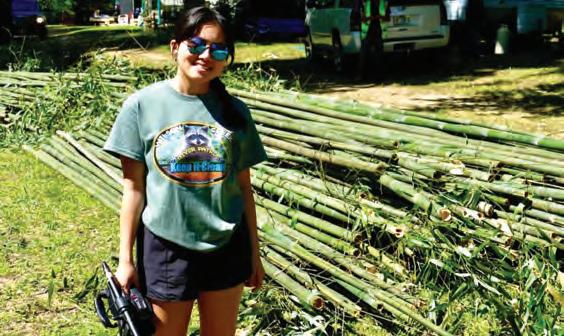
As time passed we noticed the expanding bamboo patch, which was becoming several separate patches and all were growing in strength and was now bordering the main road in places. The invasive giant bamboo grows very quickly. So fast that it overtakes the natural habitat. We knew that if we didn’t at least attempt to take out this particular patch it would become uncontainable.
Wilson Creek is a National Wild and Scenic River with a rich history that deserves to be cared for and loved not just used. To use heavy equipment to dig up the roots would leave that newly turned soil vulnerable to wash away. It took 6 months of work and planning to put this current project back into the spotlight and build a plan that we hoped would work.
Saturday, June 8th we had over 50 volunteers from many organizations show up and work together to make a difference. Hickory Trout Unlimited was given $1000 in matching funds for our spending $1000 for expenses for the project by the North Carolina TU Council.
Brian Esque, current NC TU Chair, attended and worked hard for the project.
Our concept was to cut the bamboo within an inch or so from the ground and painting a special herbicide on the cut stalks with in one hour’s time. Although it was safe for River use to spray the herbicide, painting actually applies it directly where it’s needed. Our goal was to leave the roots in place because even dead they will still be effective to hold the ground while natural vegetation takes root. So, even though we had high hopes of removing the entire patch, it proved much more difficult than we anticipated. It seems that not only are the roots a tangled mess but the tops, 40 feet in the air, are also tangled together. Over 50 people worked diligently together but we didn’t even get half of the major patch removed. However, we consider our workday a major success.
We now understand that this is sort of like research. We have learned a lot on what methods work best for cutting, for killing and for recycling. We are yet to study the effectiveness of painting the herbicide on the cut stalks but we are hopeful not only for ourselves but others who will follow that we can share our findings. A newly formed company, National Bamboo, was on site working with us for the best way to transport it from the mountain stream to their new mill in Shelby.
All in all this project although not finished offers us great insight into the future. Certain strains should NOT be planted along rivers to hold banks. We have learned lessons on how to cut and what tools to use and much more. We can study the effectiveness of our method for future work. And most importantly, working together as a community of people

By Jarrett Van Meter
Mike Kesselring owns roughly 18,000 fishing flies. There are flies from as close as his local outfitters and as far away as Japan. There are flies made for catching local trout, Taimen in Mongolia, and Golden Dorado in Argentina. He knows each one’s story and intended use. They sit stacked in 14 x 9-inch plastic divided trays that line one end of his living room in Walland, Tennessee. But none of them came from his own hands.
“I’ve never tied a fly in my life,” says Kesselring. “Except to the end of my tippet.”
Kesselring first went fly fishing in 1967 at age 15 while living on the northwestern tip of Washington state. His father was a medic in the Air Force and the family moved frequently. Young Mike did plenty of fishing along the way, in the lakes and canals of Florida, for tuna on outrigger canoes in the Philippines, but it was in pursuit of salmon n Washington that he learned to fly fish. The family was only in Washington for a year, and while Kesselring continued to fish at the ensuing stops, it was usually back on flatwater.
Eventually, Kesselring’s parents retired in western North Carolina. He fell in love with the area during visits, and in 1975 he decided to join them. He left his job at an Indiana sawmill, moved to Bryson City, and found work at a furniture manufacturing plant where his shifts
usually ended around 3 p.m. The rest of the day was his, and he used the long afternoons to get outside. For roughly his first five years in town, he spent most of his free time hiking, but when his pal John Quinnett offered to re-teach him how to fly fish, he found true joy.
“When you go hiking, you’re on a dirt trail, rock trail, whatever, and you’re seeing nature, but it’s the same,” Kesselring says. “When you go fly fishing, you’re in the middle of a creek, you’re wading in water that has never been the way it is. It’s always changing. It’s always moving.”
The fly collecting, he says, “kind of started by accident.” He would buy a few extras flies on every trip to the local fly shop. A few of these, some of those, and soon he found himself with a healthy surplus. Kesselring collected stamps from new places during his itinerant youth. It wasn’t long before he was similarly seeking out fly shops every time he traveled, looking for flies specifically made for the waters in that area. As the internet became more accessible, he began buying flies from individual tiers, first in the United States, and then from around the world.
“I was able to add a lot of neat stuff that you would never be able to buy here in the United States because nobody would be using it for the kinds of trout available,” he says of his international purchases. “That was what was becoming more and more interesting, much in the same way stamp collecting had intrigued me with learning about other places




around the world.”
Among his favorite acquisitions are his Tenkara flies. In 2019, when Kesselring reached out online to a traditional Tenkara tier in Japan, the man responded that he would be happy to send some flies, but rather than money, he preferred that Kesselring send him a book about fly tying, as they were harder to come by in Japan. Kesselring agreed to the terms, sending him one of his books in exchange for what he thought was going to be a dozen one-off Tenkara flies. When the package arrived, he opened it to find double that.
“They were just beautiful,” he says of the flies. “And the guy didn’t want anything but a book [that] cost me like five bucks at a used bookstore years ago, and he reported back and showed me a couple of flies he tied from it.”
Kesselring is committed to protecting the waterways that have brought him so much delight. After retiring from a 25-year career as a professional photographer, he has spent the last 14 years volunteering at Great Smoky Mountains National Park, helping the fisheries department with efforts to restore brook trout native to the park’s watersheds. He now lives just over the state line in Tennessee but coordinates other volunteers to help take water samples from the waterways on the North Carolina side of the park. He finds the work rewarding and is proud of the results, saying due to the department’s efforts the park has a “really good profile of the water quality and how it has improved over the decades.”
Matt Kulp, the park’s supervisory fishery biologist, says that when it comes to living a life of stewardship, Kesselring walks the walk. “He definitely has a love for these mountains and for fish and trout,” says Kulp. “He tries to demonstrate that in a lot of different ways, and he goes above and beyond in terms of his time and effort. He takes a whole day when he does the water quality collections, driving volunteers around and collecting samples himself.” Kesselring estimates he dedicates 300 hours a year to the role.
As part of his outreach, he occasionally gives presentations and programs for area Trout Unlimited chapters, displaying his fly collection and engaging with audience members. His database of volunteers that he has collected over the years is up to around 450 people. Unlike his 18,000 flies, they are Kesselring originals.

By Capt. James McManus
Well, the last few weeks I’ve had lots of folks from Florida on the boat. The fishing has been great; we’ve caught good numbers and good size, but that’s just part of why I’ve realized how blessed I am to be in the mountains. Most have talked about the lack of rain, oppressive heat, traffic congestion, all the things I don’t miss about being anywhere but here.
Had quite a few young kids, and their perspectives on fishing here have been priceless. My favorite conversation lately was with a young man who fished on his high school bass fishing club. We were trolling
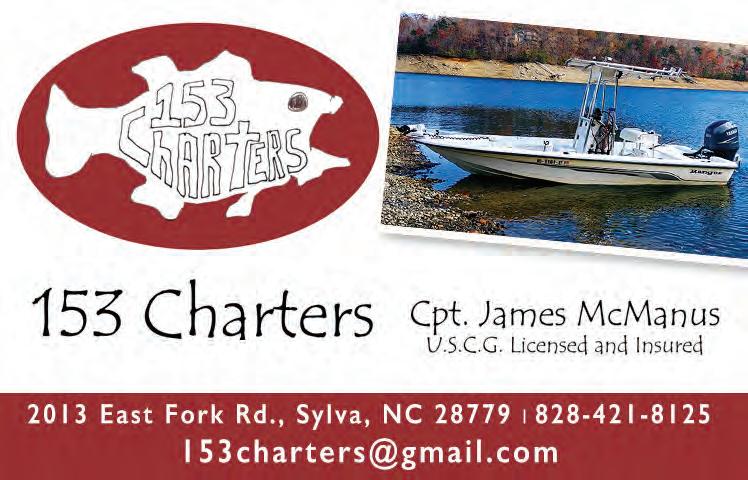
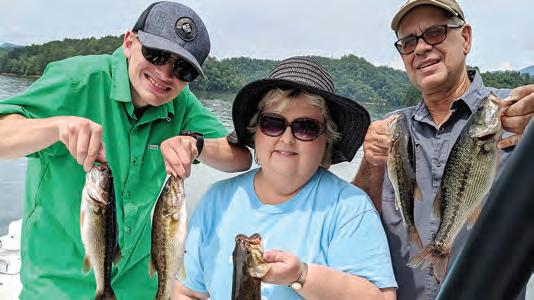
down near the dam at Fontana, catching trout on downriggers with spoons. He had asked about largemouth fishing and whether there were any lily pad areas on the lake, saying in Florida right then they were hiding in the shade as it was sweltering hot. I explained there weren’t any and that our bass just went deeper when our temps climbed or moved out into open water. Also, I added that we didn’t have many largemouth, mainly spotted bass and they were a different animal.
A couple of minutes later we had a fish on and a two and a half pound spot jumped across the back of the spread. After a good accounting of his strengths, we netted it and the kid went crazy. He had his picture snapped, snapped a view of the sonar, “ I just caught a bass in 350’ of water, fifty feet down—the guys at home are going to freak!”
This is an amazing place. Beauty without equal, uncongested waters, fish galore and a “You ain’t in Florida no more, boy.” feeling. I try and remind myself of that almost every day and thank the Lord for these blessings.
Y’all give me a shout if you want to catch a few.
Later, Capt. James
Capt. James McManus owns 153 Charters. Give him a call for a great day on the water at (828) 421-8125


By Joe Woody
Ihave a list of things that bother me out in the woods, especially when I’m by myself. The list has decreased over the years as I’ve become more and more accustomed to what nature throws at you when you’re chasing the high lonesome.
I’m not saying I don’t get the “Heebie-jeebies” every so often, but at least I can explain those bump in the night sounds more so than I used to. Here’s a short list of things that make the hair on the back on my neck stand up:
Hikers walking past who refuse to speak or acknowledge you.
Widowmakers…look it Up.
Yellow jackets.
Rattlesnakes on the trail.
Wood knocks at night when you’re by yourself.
That’s not all of them but you get the picture.
Bears don’t freak me out as much as they used to. Most bears are indifferent to or scared of you. You may find a curious one every so often, but a simple holler or hand clap will send them running.
A coyote howl can be unnerving at times, but I can count on my fingers the times I’ve actually run into them. I now accept the howl as a cool reminder that I’m in the wilderness. Don’t get me wrong. A close coyote howl near your campsite when you’re alone can place you on high alert, but I’ve learned to just roll with it.
There are those undiagnosed sounds and occurrences that happen. If you are lucky enough to spend time in the woods alone over time, the
spirit in the woods will reach out to you. It’s up to you to accept it or not. Our Native American friends are correct when they tell you that the “Great Spirit” is alive and well…especially in remote places in our Southern Appalachians, but that’s a topic for another time.
My biggest and some would say unwarranted concern is…wait for it… hogs.
I’m not talking about the cute pink variety that kids chase around during greased pig contests. I’m talking about the brown hairy ones who’ve de-evolved back to their wild state. Even scarier are the Boars. These creatures have Orc like curved tusks protruding out of their jaws like curved Arab Scimitar swords. They are thick and muscular and run in packs.
I’ve had just a handful of encounters with them, but that in no way should make you believe that they are few in numbers. All you have to do is walk up a trail in the Smoky Mountain backcountry and pay attention to the tracks and rooted up sections on the side of the trail. Hogs do that. In some places you would think heavy tracked machinery were the culprits, but that is not the case. Hogs will flat root up a place. It can be quite eye opening.
If you would like to test just how much hogs can amplify the pucker factor, take a summertime walk to one of our balds in the high country. Find a trail skirting the highest peak. You will find yourself walking through high grass on both sides of the trail. Look down and you will find freshly rooted up ground. Stop for a few minutes and don’t make any noise. You will start to notice freshly made trails running into the


grass. Listen closely and you will just be able to make out little squeals and rustles in the vegetation. You will slowly realize that you are in amongst a family of wild hogs that can be aggressive in the protection of their young. They are smart and some old timers will say vindictive.
I need put out a disclaimer here. There have been no instances of fatalities from hogs in our mountains, but that does not mean you should not be on hog alert. I mean, there’s no reason to not be. Let me tell you a story of a recent hog encounter I had…
I don’t particularly like to change my plans when I’m going out into the back country. It can only lead to problems, but on a recent trip, I did exactly that…three times.
I was headed out to explore Pilkey Creek on the North Carolina side of the Smokies. Pilkey empties into the north side of Fontana Lake situated a few miles between Hazel and Forney Creeks in a very remote section of the park. I was headed out with my friends Ben Bailey and Chris Ramsey in Chris’s boat.
The plan was for the three of us to explore Pilkey Creek the first day,
then leave me, my gear and my canoe on Pilkey where I could explore the creek fully for a few days after they left. But after a few hours on the creek, it was obvious that three to four hours would be plenty to fish most of the creek that was fishable.
Change 1: We then decided to drop me off on Hazel Creek where I could spend a few days fishing and exploring. But on reaching the mouth of Hazel, we discovered that the lake level had dropped to a point where it was impossible for me to get across without swimming. The wind was blowing, and the temperature was dropping, and I didn’t want to get my clothes and gear wet. So, I decided to adjust my plans once again.
Change 2: We then decided to drop me off on Olly Cove just a quarter mile out from the mouth of Hazel Creek where I could then make a short one mile hike up over Olly Gap and approach Hazel Creek from the Northeast where my camp site at Proctor waited for me. I waved goodbye to Ben and Chris, then turned to start my hike. Not long into the walk, I noticed the obvious signs of Hog Wallers. They had completely rooted up the ground in all directions. If you listen, the wilderness will let you know.
As I approached Proctor Campground, I looked across the bridge and just to the right of The Calhoun House, standing in the field, was a large solitary animal. At first, I thought it was a big bear, but as I got closer, I realized it was a huge hog. I still can’t believe how big these animals get.
I walked past to my campsite, found a suitable spot and began setting up my tent, then built a fire. I walked over to the river, near the bend just above the spring hole, to admire its water and dream about the fish I’d caught out of it in years past. As I stood there, the serenity of the evening was interrupted by a huge “ker-plunk” in the water.
At first, I thought someone had thrown a rock at me, but there were no signs of anyone else in the campground and in fact there we no signs that people had been there for days or even weeks. I then thought it had to be a beaver slapping its tail at me to warn me off, but I saw no beaver.
Continued, see HOGS ON HAZEL CREEK Page 19

By Taylor Klarman

Another GSMNP gem is Abrams Creek. Situated at the halfway point, between the Tellico River and Gatlinburg, lies this true, blue ribbon stream. With the largest population of wild trout in the park (5,000 per mile) it’s not one to miss! If you’re looking for a beautiful destination with great fishing, this is it! Many anglers would even go as far as saying it’s one of the best trout streams in the entire park! It has an abundance of insect life and the fishing here and plenty of access points from Cades Cove or through various campgrounds along the way. Although most fisherman here are day trippers, there is an opportunity to extend your chances of success and make a weekend out of it as well.
This section is found near the intersection of Abrams Falls trail, Hannah Mountain trail and Hatcher Mountain Trail. Hiking in is the only way to access it. With access both from the North Side (Cades Cove) and the Southern Side (Abrams Creek Campground), it makes the most sense to drive to the campground and hike up. Most of the stream below the campground is unwadable because of the depth of the water here. You’ll find from the campground to the intersection of the trails mentioned above characterized by much slower moving water and deeper pools. Still a great place for trout to hide!
Middle
Just above Abrams Falls, from the 2nd horseshoe like curve in the stream, to 2 miles below Abrams falls makes up this section. This section receives much less pressure because the trail gets a bit more demanding after Abrams Falls. For about 2 miles after the falls, you’ll find a pretty amazing section of river to fish. Most of this is accessible trailside, with a few spots that may require some off trail exploration in order to reach the creek. It should be noted that the further downstream you go, the

more the creek loses its mountain stream characteristics and starts to open up more.
Headwaters
You’ll find the headwaters, or at least the section of it that appears above ground, near Cades Cove. This section contains what some anglers call the best section of Abrams Creek, The Horseshoe. With most of this section trailside to Abrams Falls Trail, the stream leaves the trail and follows a circular like pattern and ultimately returns back to the trail where it left. There is about 1.3 miles of stream in this section that don’t receive a lot of pressure and house some pretty spectacular fish. From Cades Cove to right above Abrams Falls makes up this section and it’s creek like characteristics begin to diminish the more you go downstream. With the exception of the Horseshoe, most of the upper reaches receive more pressure due to the easy access, appearing in March and make for some great options on dry fly fishing coming out of the winter months.

Located in the far Northeast corner of Tennessee amid the Cherokee National Forest is the Doe River. This is another truly wonderful mountain stream fly fishing experience. Located at the base of Roan Mountain, this part of the Doe is a wild and wonderful experience. Running from here it twists and turns down the mountain where it will ultimately join the Watauga River. There are 2 primary sections to fish here because a lot of the river runs through private property. Don’t let that deter you though. The public access portions are definitely worth the trip. You’ll find native brooks, browns and rainbows here, with a healthy population of stockers as well.
Roan

The Watauga River is another great tailwater fishery in East Tennessee. Located in Elizabethton, just outside of Johnson City, the Watauga starts at WIlbur dam and flows to Boone Lake. It’s preceded by 2 reservoirs, Wilbur and Watauga Lake, that prove to keep the Watauga’s water cold and productive year round. With it being a short 25 minute drive from Bristol, Virginia, this blue ribbon fishery is a must fish when visiting this region. It holds some truly spectacular fish and what you don’t catch in numbers, you’re sure to make up for in size. It has 2 primary tributaries in the Doe and Little Stony Creek, both of which are excellent fisheries in themselves. You’ll find rainbows and browns to average around 10-12”, with the trophy section boasting the area’s best shot at some truly large fish.
Trophy Section
This section can only be fished when the river is generating. The put in is at Blevins Boat ramp, but the true trophy section doesn’t start until you get to the bridge at Smalling Rd. There are tons of runouts and pools through here and are best fished dead drifting streamers near the eddy lines. We’ve caught some monster rainbows out of here, but browns are present too. If you’re nymphing, be sure to adjust your line length for proper depth frequently as it does change throughout here as well. In addition to its being great for fishing, it’s just a beautiful area to enjoy the scenery as well.
Siam Bridge
With good roadside access, the Siam Bridge offers a great section for wade fishermen. Although this river is best fished from a drift boat, you’ll find a few good spots to wade in along the way. We generally park right before the bridge and walk down to the right to get in the river. There is an old bridge foundation that trout like to hang around. There is a ton of grass beds throughout this section as well, giving the trout the perfect place to hide and chase after some food.
Moose Lodge
Another great spot to wade fish is the Moose Lodge. Situated right next to the confluence of the Doe River, there is a large parking lot anglers can use. Walk across the grass lot to the river and you have a good chance for good fish. Do try to park toward the back of the lot, especially if they have a function going. Although the land is private property, they are pretty generous to fishermen. Normally during the day, you should be fine parking here. The best spots for fishing are upstream of the confluence. There are several ledges and runs through here which have produced good fish for us in the past.
As you enter the park, you’ll find the road parallels the stream. A lot these sections have pull-offs that you can access the river from. There is also a lot of private property here as well. The national forest starts about 100 yards downstream of the visitors center. You can fish anywhere through here up to where the campground is. We generally start out at the campground and hike up the trail that parallels the creek. You’ll find various sizes of fish here, but they average around 6-10 inches. As you can see, there are some big trout here as well.
Doe River Fishing Trail (DRiFT)
The Overmountain Chapter of Trout Unlimited established this trail in 2018. It has public access points in 6 different areas that span around 8 miles. There are also several single car pull-ins along Old Railroad Gauge road that provides access as well. This section primarily has stocked trout, but there are some wild trout to be found here too. The advantage of this section is that everything is accessible near the road way. This is also a disadvantage as well because you may have some traffic noise to deal with. The portion that runs through town is mostly private property. Most of the trail is highly marked though to leave out room for confusion.
About 13 miles due East of Tellico Plains, TN (at least as the crow flies) lies

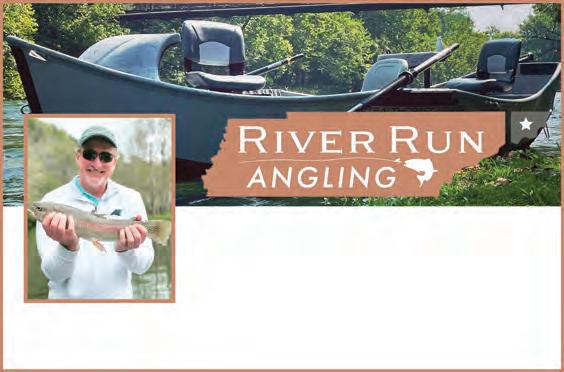
By Ronnie Parris
Hey folks hope you’re all doing great. Well this month’s article is a little different. It was time for our spring vacation so what’s a fishing guide do for vacation You guessed it you go fishing. This time we went to one of my favorite places Steinhattchee Florida. First day there, after dropping off our luggage at the vacation house, we jumped in our rental boat at the Sea Hag Marina and Penny and I were out to sea.
After questioning the staff at the marina an finding out the bite was on to the south, you guessed it, we headed north to one our favorite spots. The bite was slow at our first spot, but after a little searching we figured out what depth was working and began to catch. Penny was catching on live shrimp and gulp alive shrimp in the new penny color, while I was casting a pink jerk bait that’s worked well over the years.
We set 2 heavy duty rods in the back of the boat rigged with live pin fish we caught hoping to catch a cobia, shark or other large predator fish. I rigged those rods with 50 pound test with a steel leader fished under a popping cork. Our first few hits were from sharks that just cut the bait in half an never came back. After boating 50 or so trout, pin fish, catfish and jacks, the drag on our big set screamed. Penny grabbed the rod, and the fight was on. She had hooked into a really nice cobia. After several long run he began to tire, and she was able to get it to the side of the boat where we were able to land it.
On this trip we caught 16 different species of fish including some great eaters such as flounder, pompano, cobia, sea trout and many more. There were days where almost every cast you were gonna get bit. Really, the only problems we had all week were the wind knots from casting

the light jerk bait with braid, and the crazy rabbit puffer fish that kept eating our big baits and would swim past the steel leader, eat the monofilament line and chew up the Styrofoam popping cork.
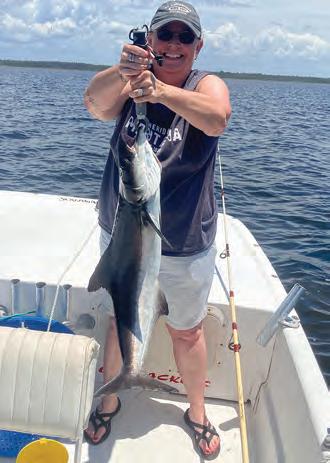
If this kind of vacation sounds like something you would enjoy. Contact the Sea Hag Marina in Steinhatchee Florida for accommodation and boat rental. As far as gear and fishing techniques, it’s fairly simple. Anything resembling a minnow is good. Live bait, such as shrimp and pin fish, works good. One of the funest things is you never know what your gonna catch next. From shark to flounder, it’s always a surprise.
Anyone wanting to go and needing a little information can contact me at +18287369471 or my buddy captain James McManus at 828-4218125. Have fun and stay safe, and as always, take a kid fishing!
Ronnie Parris is owner and head guide of Smoky Mountain Outdoors Unlimited-Fontana Lake Fishing Guides, headquartered in Bryson City, N.C., www.smokymountainoutdoorsunlimited.com; (828) 488-9711.
PROJECT continued from page 2
who are interested in being a part of the solution.
Wilson Creek has long seen hard times in its past, especially with only the bad publicity being in the spotlight. Organizations working together do make a difference and supporting each other will offer a clearer focus for the creek’s future. TU groups from Hickory, Boone (High CountryTU), Morganton (Table Rock TU), Charlotte ( Rocky River TU), Winston Salem (Blue Ridge TU) and Greensboro (Nat Green TU) were accompanied by people from A Clean Wilson Creek, Carolina Land and Lakes and Foothills Conservancy. We had people drive for up to 3 and 4 hours away just to join us. Also, I want to acknowledge the campers, our families and friends. To one and all, we want to say thank you so much for all your hard work, for coming so far and for loving our Wilson Creek as much as we do.
Our biggest lesson learned is simply, TOGETHER IS THE ANSWER!

Fontana Lake Fishing Guides – Ronnie Parris, Owner & Head Guide LAKE, CREEK & RIVER FISHING • FLY FISHING • CAMPING
We o er both full and half day trips with the most competitive rates available. All tackle and supplies you will need while you are on your trip is covered by our listed price.

Provided by Captain Jim Durham, Owner StriperFun Guide Service, Tennessee and Kentucky Walleye, Bass, Crappie and Muskie Charters, Superbaittanks.com, Captain Jim Marine Electronics and much more DATE OF REPORT: August
Greetings to my readers! I hope that the world finds you and your family doing well!
Cherokee Lake in eastern Tennessee covers 30,300 acres, is 59 miles long and has 463 miles of shoreline. Cherokee Lake is full of big stripers but is also “loaded” with big fat “hybrid” stripers as well! StriperFun’s guides are all over them! We average 20 fish days catching both striper and hybrids! We fish live bait and case Captain Jim Striper Magic lures (see our website) to surfacing fish, August and September are great months to fish! Our 5 guides all have decades of experience!
Captain Jim’s StriperFun Guide Service Cumberland River Adventures fishes the Cumberland River in TN and KY for several reasons. First, the stripers are much larger in the Cumberland River system in TN and KY than other fresh water arears. Per the two States’ wildlife agencies, there is an average of over 15 stripers caught annually in excess of 50 pounds and 40-pound fish are not uncommon. The smallest fish we generally catch daily is over 3 feet long! These fish mostly eat high protein rainbow trout, large gizzard shad and skipjack and also fight the current all day,
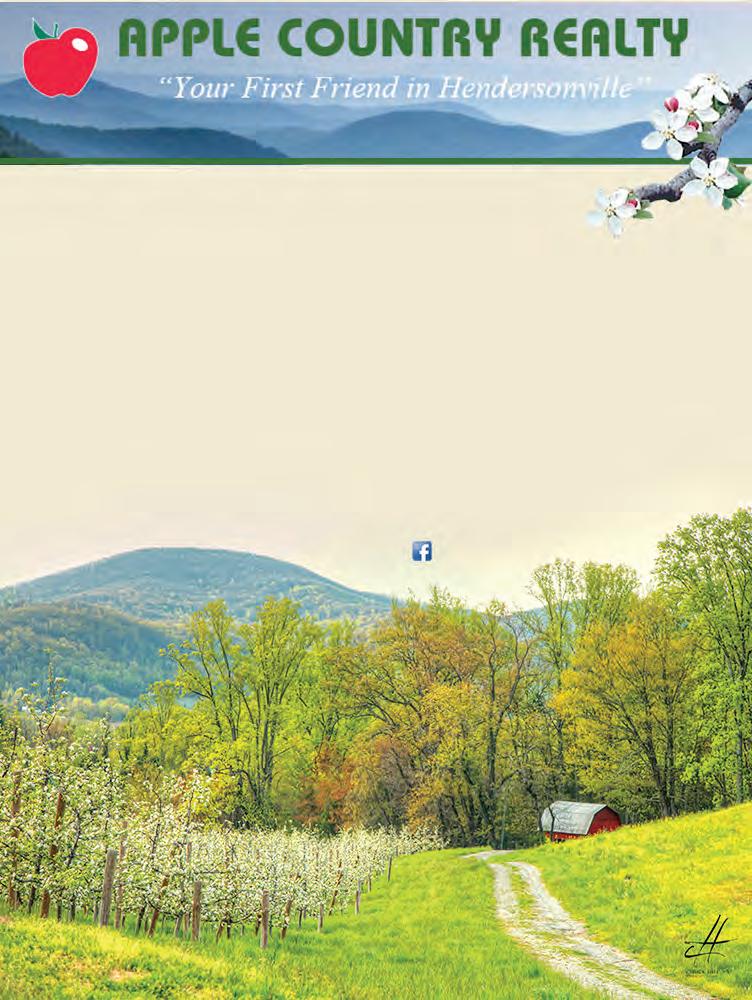
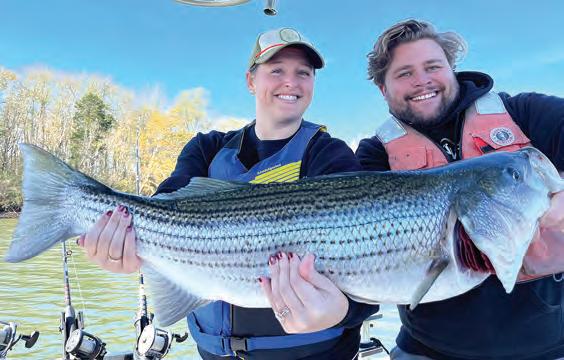
making them much heavier and stronger than “lake” fish.
In the cold waters of the Cumberland River, the caught fish survive very well and can be released unharmed. The average size trout we use in TN for bait is 12 inches with some up to 16 inches long (we do casting trips in KY) and we also occasionally use big skipjack up to 20 inches long (yes, the stripers in the Cumberland River are large enough to eat a 20-inch piece of bait!). When a big river striper comes after a large bait, the bait will be tail dancing all over the surface trying to get a way. Sometimes the “dance” will last half a minute (as you watch the big predator circling the prey!) until the striper finally gets the big bait then its “kabam!!” The rod gets yanked down and the reel is screaming! We also catch huge fish casting Captain Jim Special (see photo) Striper Magic “glide” baits and my mini umbrella rigs!
As I advised above, throughout the year, it is not uncommon to see 40 or 50 pound “goliath” stripers pulled from the beautiful waters of the Cumberland River. This fishing is not for the faint of heart however! These big fish hit like freight trains, making long powerful runs in the constantly flowing waters of the river! We use large rods, heavy duty reels, 50-pound test line and titanium hooks!
It is great to be alive and be a “free” American! I look forward to seeing all of you this year on the water. Always remember to stop and shake the hand of a person in uniform or wearing garb that shows they are a veteran! Their service is why you speak English, can vote and can enjoy the freedoms you do!
Until next time, blue skies and tight lines!
With full State licensing and insurance, all Captain Jim’s Guide Service guides (19 guides on 18 waterways fishing 9 different species of fish) can take you on a safe, fun and unforgettable fishing adventure! Check out all of our fishing services as well as our exclusive “online” store at www.striperfun.com or call 931-403-2501 to make reservations today.


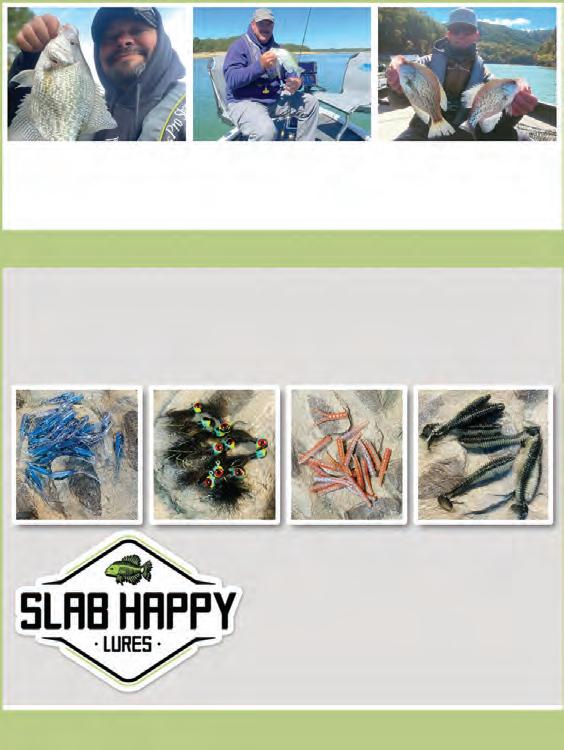
By Perry E. Hensley, Sr.
t’s hot and muggy, and those crappies can be tough to catch, right? Well we are going to go over with you some proven tactics to help you catch crappies during the Dog Days of summer.
The First would be the old tried and true method of fishing with minnows. Be it using the Slip Float Method or just tightlining minnow the first thing to find (and it shouldn’t take long) is bait. Most lakes will have loads of shad/bait schools all over the lake, especially here in the south.
One you have established where the bait is and you have chosen a technique now it’s time to find a pinpointed location. In my opinion you will need to find some structure under some type of cover or in shade (Crappie love shade). Do not rule out Shooting Docks with artificial baits. Whether its actual shooting docks or dropping a minnow alongside a dock both have proven to be effective.
Another location would be bridges. Bridges have both structure and cover/shade and a lot of angler night fish under bridges using lights which will attract the bait which in turn attracts the slabs (and other fish) to your exact location so be prepared to catch a catfish, drum, white bass and/or bluegill! Crappie will choose to hang in most cases on the backside of the bridge columns on the current break side so choose your anchor point accordingly.
Whatever technique you choose to fish or the area you choose it is important to know where your thermocline lies in your lake to maximize your attempts to catch a boat load of those finicky summertime slabs.
The absolute best advice that I could give would be to get off that couch and get out there with those you love and make some memories as you enjoy all that our God has given us!


Summertime in the South ain’t no joke! The blazing heat of August pretty much shuts down the fish’s appetite in the afternoon. This leaves the early morning or the dark of night to have a chance at finding active fish.
Water temperatures on our lower elevation trout streams can reach dangerous levels making fishing not a good idea. Any trout hooked is in real danger of exhaustion and going belly up so maybe waiting for the cooling breezes of Autumn is a better idea! In some higher creeks up on the mountains you might find water temps below 65 degrees making fishing possible. Tailwater fisheries usually will be fishable at least a few miles below the dams.
Warmwater species may be a totally different story at least if you fish in the morning hours. Lakes, ponds and rivers that contain bass and bream remain fun and sporty even in the dog days of summer. If you’re on at daylight and off at noon you can normally find some willing fish and miss the throngs of fun seekers ripping up and down the lake.
In the first hour or two before the sun gets up over the shoreline, I usually like to throw poppers or frog patterns around the bank with good cover like logs or over hanging bushes. The strikes can be explosive and will wake you up if you missed that second cup of coffee! As the morning goes on I start working deeper into the water column first with popper dropper rigs and by ten am or so I’m in full bottom dragging worm, crawfish, or fly drop shot rigs in 8-10 feet of water.

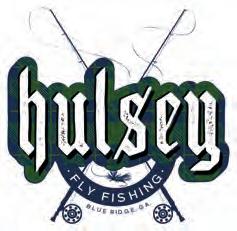
Always be on the lookout for streams or springs flowing into the lake as these will usually be hot spots, or I should say cold spots, that will have feeding bass and bluegill lining up with the feedbag on. Any type of vegetation or boat dock that provides shade can also get you a few bites as well while punching or pitching heavy flies through or under them. Fish early and leave early are the words to remember during the dog days of summer.
Give David & Becky Hulsey a call at (770) 639-4001 to book a class or a guided trout trip. See his website at www.hulseyflyfishing.com

ON
CREEK continued from page 9
I shook this off and started walking down the muddy bank to check for animal tracks, which I do almost everywhere I go. There were dear, fox and hog tracks, all made recently by my calculations. I thought I saw the remnants of a bear, but it was old and hard to make out. I then returned to make my dinner.
I was making my favorite dehydrated meal of Peaks Beef Stroganoff when I made a bad mistake. When pouring boiling water into the bag, my hand slipped on my pot causing the hot water to land on my hand instead of the noodles. In response, I dropped the aromatic contents directly on the ground. Now, some of you realize that I had just rung the dinner bell for all hungry animals in close proximity to follow their noses into my campsite to investigate the delicious goodness I’d just spread all over the ground adjacent to my tent.
I cleaned it up as best as I could, brushed my teeth, completed my necessities and decided to hit the rack, forgoing the dinner now spread over the dirt. I wanted an early start and would make a good breakfast the next morning.
I fell asleep quickly and deeply, but around midnight I awoke to a god-awful sound. I don’t know if you’ve ever been in close proximity to a bunch of hogs fighting, squealing and God knows what else right beside your head, but it will clinch up your cheeks.
I did not make a sound. For twenty to thirty minutes these animals continued to circle my tent. Then…they all screamed at once and ran into the night. What had scared them? In a few seconds, I figured it out. Right outside my tent where I’d dropped my dinner, I heard a very large grunt, then scratching on the ground followed by more snorts and grunts. Either this was largest hog I could imagine, or a big bear had moved in to claim the remnants of my supper. I could feel its breath right beside my head. It would make lunges at my tent trying to scare off the Big Agnes logo across the front of it. This went on for another fifteen to twenty minutes.
The big animal finally ended its standoff with my tent and moved away. I eventually went to sleep, but to say the sleep was restless would be an understatement.
I exited my tent early the next morning to survey the carnage I knew had happened the night before. Just as I thought, the ground had been rooted up and there was a suspicious dig next to my campfire, but all the participants had disappeared. I made breakfast, did my necessities and walked back down to the river to ponder everything that had happened. As soon as I approached the water, another “ker-plunk,” bigger than the day before, exploded in the middle of the creek, but again, the guilty beaver was nowhere to be seen. Concerned but not deterred, I walked back up the creek to study any new footprints in the muddy bank. There, plain as day, were two children’s bare footprints. I’m pretty sure they were not there the day before. Matter of fact, I was pretty sure people had not been at the campsite for several days, especially children.
I pondered this for a while, then decided that nothing was worse than not fishing, so I readied my fly rod and walked down the trail to the spring hole where I intended to fish. Before I could make my first cast, I bent my fly rod up in a laurel bush and broke the tip. My fishing trip was over before it began. I usually carry an extra rod, but on this occasion it was safely in my truck under my seat. I decided it was time for Change 3. I packed up my gear, walked the mile back to my canoe and cut my trip short by two days. There were other weird occurrences on the trip back to my truck, but I’ll have to tell that story another time.
I guess the moral of these misadventures is to stick to your original plan or chaos might ensue…but chaos can sometimes make the best story. Oh yeah! Hogs are freaking terrifying.
Joe Woody is Co-Publisher of The Angler Magazine Great Smoky Mountains with his wife Debra. He is an Army Veteran and a self proclaimed “Adventure Angler”. You can usually find him wandering around Western North Carolina telling fishing lies. He is also a baseball nut and a crazy FCS Football fan. He has a Bigfoot magnet on the back of his truck.

By Scott Norton
If you have not been to the lake in a few weeks and wonder what happened to all the bass, let’s think about this logically. The shad spawn is tapering off and you are starting to see offshore activity like blowups and pods of shade over deeper water. To know where to start you need to know what kind of lake you are on. Are you on a highland or lowland lake, and what is your elevation?
Lowland lakes are self-explanatory. You have low elevation and lots of grass where the sun has penetrated the shallow areas. Your bass will be one or two places. They will go in the thick brush and grass, up shallow, or they will be on the grass edge. This situation happens before the highland lakes because the lower elevations warm before the higher lakes. The higher lakes have a similar situation happen but without the grass edge. If you decide to stay shallow you will be flipping and pitching or fishing the docks. If you go offshore you will be fishing the color line, where the water turns dark.
We are now in the summer patterns. What baits do you select for each plan? Here is more logical thinking. The bass that are offshore are there for the shad, bluegill, and trout. It makes sense they would follow them where they go. In the shallows, bass go for more terrestrials. They will feed more on frogs, rats, worms, and crayfish. You will be flipping, pitching and skipping baits in hard to get to hiding places. Groups of anglers like this to work on the casting skills and accuracy.
Bass that are offshore go deeper where the light cannot penetrate on the color line or they will ambush forage on the grass edge. These bass in the color line are looking up to feed on what is above them. This where you

get those blowups. Bass on grass will use the edge like it is a shoreline. You will have points and pockets just like the shore. During this period, do not forget about night fishing as well. Some bass go nocturnal due to the pressure and activity in the daytime hours. You can usually get into a class of bass that will not eat in the day. These fish are smart and big in most cases for a reason. We have always seen huge bass in the day if you roll up on them or spook them. You can throw the whole book of fishing at them and they will just sit there and look at your bait. Chances are these bass are biting at night. The times to go would be the week leading up to the full moon and a week leading up to the new moon. Be a logical thinker and do not fish from memory. Bass are always on the move and are motivated by their hunger and experience.
Scott Norton is a Western North Carolina native. Born in Asheville, N.C., he is a long-time hunter, angler and weekend warrior.


By Capt. Cefus McRae, Nuts & Bolts of Fishing Series
Owning and operating a boat is fun. It’s a great way to get out and enjoy the outdoors, spend time with family, and discover new fishy destinations. It also carries some responsibilities, that are not to be taken lightly. Safety being at the top of the list.
No matter who owns the boat, the person behind the wheel is 100% responsible for the safe operation of the vessel, and 100% responsible for any damage done by the boat OR the boat’s wake. So let that sink in a little bit.
On a beautiful day, when the water is like Teflon and there’s hardly any boat traffic, you can crank her up and just enjoy a pleasant ride. But on busy summer weekends, even the typically calm waters of our regional reservoirs can get churned up like the Gulf of Mexico due to the wakes from 100s of boats. And with no traffic signals or marked highways on the water, it’s crucial that everyone knows and practices navigation Rules of the Road. Never heard of that? You should have. These rules set the procedures to follow when two boats are approaching from opposite directions… when entering or leaving a channel…who has the right of way…and so much more. They are in place to keep our busy lakes, rivers and waterways from becoming even more chaotic.
As the operator of a boat, you are also responsible for carrying certain Coast Guard Required Safety Gear on board. I know, you’ve heard me say this a thousand times. But it’s worth mentioning again. As a matter of fact, I recently had an encounter with a Florida Wildlife
Officer who stopped me at a boat ramp for a random vessel inspection. This officer was extremely professional and polite. We started with checking there were enough PFD’s on board for the number of people we had, and they were properly sized to fit each person… adult or child. Then on the Type IV throwable device. Then fire extinguisher.. (I have two). Then he asked for my registration…check. All good so far. Then, he asked to see my visual distress signals (flares). No problem. And as I was getting them out, I realized I had not checked the expiration date on them for some time. Oh my God! I’m really hoping these had not expired. He looked at them and then showed me the expiration date was two months ago. Suddenly, I was not in compliance. I owned up to the fact that I had not checked them recently, and it was totally my fault. Fortunately, this kind officer didn’t write a citation, but did say he expected me to correct the problem immediately. And I did.
Visual distress signals are something that’s easily overlooked by recreational boaters and anglers…just like me. And that’s especially true for folks who only boat on freshwater lakes. If you are boating on a federally-controlled body of water, regardless of whether it is fresh or salt, you are required to have Coast Guard approved visual distress signals on board, and they must be within the serviceable dates stamped on the flare itself. Flares are not just for offshore saltwater folks. That means if you are boating on lakes like Lanier, Allatoona, Hartwell, Clark Hill, Okeechobee, Kerr and others, you must have visual distress signals on the boat. Quite frankly, if you ask me, you should have them on board regardless of where you are boating.
So stop what you’re doing, walk out to your boat and check that you have the correct, required safety gear on board and check the expiration dates on your flares. While you’re at it, make sure your bilge pump is functional, your battery connections are good (and not corroded), and


your navigation lights work properly. Not only will this quick check save you some potential issues with the authorities, but you’ll also have peace of mind knowing you have the right gear on board if you should ever need it.
Tight lines and calm seas, Capt. Cefus and Buck, the Wonder Dog.
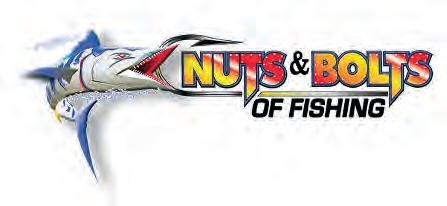
TENNESSEE FLY FISHING continued from page 11
Citico Creek. It’s tucked away in the Cherokee National Forest in Monroe County, Tn! You’ll find wild and stocked rainbow, with wild brown trout here and the native brook trout as well. Towards the lower stretches, where it runs into the Little Tennessee River, you’ll run into other types of fish like catfish and smallmouth bass. It’s headwaters lie in the Citico Creek Wilderness area near Brush Mountain. The north fork and south fork are your best bet for going after some wild trout. You should take note that there some regulations you need to adhere by during certain times of the year. You can find more out about that here.
Double Camp Recreation Area
This is a wonderful area if you’re looking to get away from the crowds. There are several campsites back here and the fishing is pretty good too. Even during the busier months, this area doesn’t see as much action as a lot of other primitive campgrounds. During the warmer months you can wet wade here, but I would definitely want waders starting around September and October.
Citico Creek Road
This road parallels the stream up until the confluence of the North Fork and South Fork. There are several places to park along the way and enjoy the fly-fishing there. Some days, you can be content to stand in one section all day long because the scenery is just that good.
Taylor Klarman is a retired United States Marine. The long road of completing a master’s degree in business and working various jobs was just not enough to fill the vessel of life. Fishing has always been a pillar of Taylor’s life as he is a native of Mobile Bay, Alabama. He grew up competing in the thriving fisheries from Florida across to Venice, LA as the crow flew. Fortunately, The Marine Corps took him to many places in this life and freshwater fly-fishing became his addictive pastime while in the service. View all posts by Taylor Klarman at https://riverrunangling.com/blog author/anglingrocks
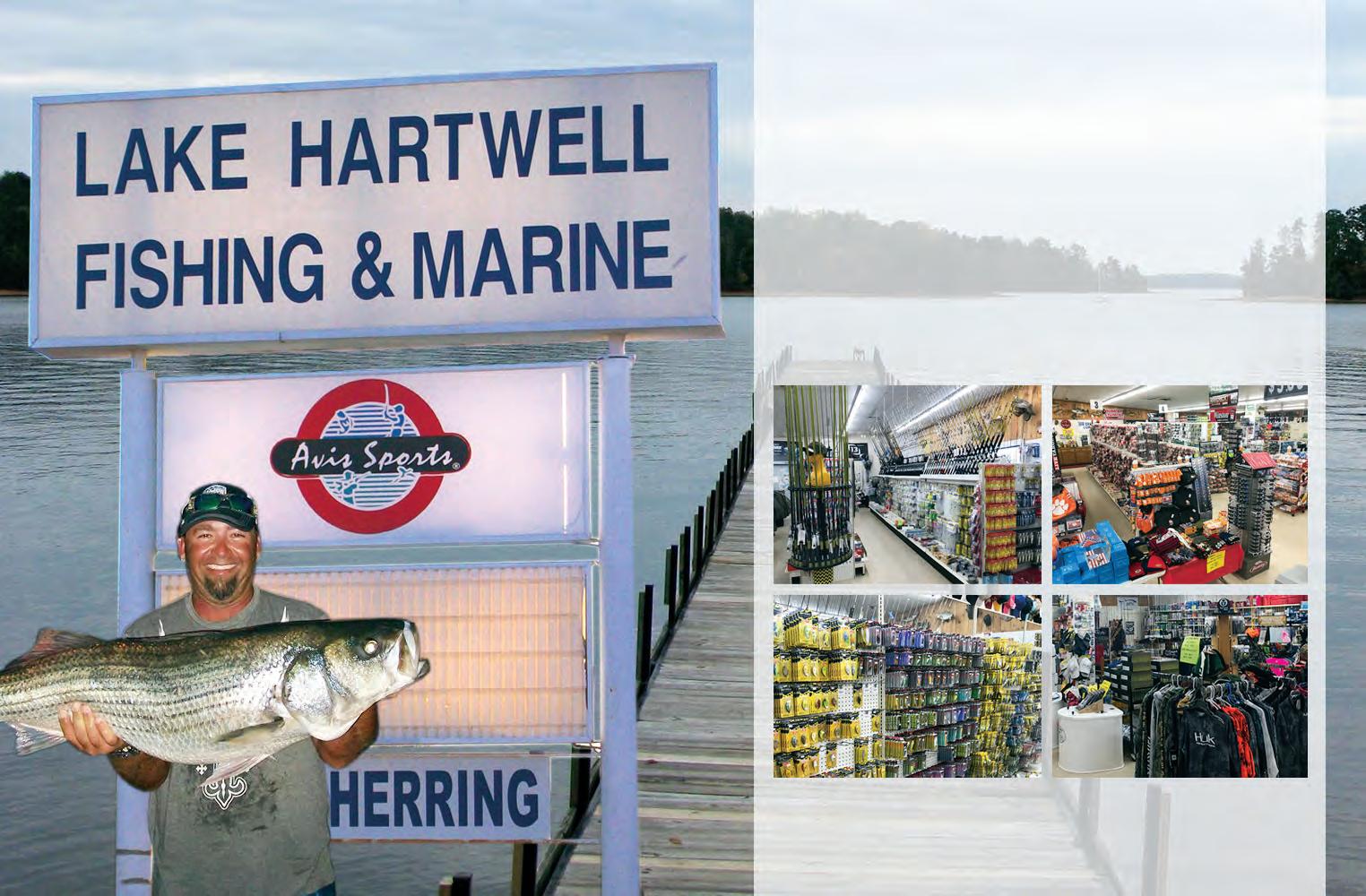

























on high alert, and the noises of the day silenced, the bites can be startling and give the impression that the fsh is larger than it is. Tat’s part of the excitement of a topwater bite! I only use this tactic in areas I know well, for safety reasons, of course.
I know wading isn’t for everyone, and night wading is for even fewer anglers, but there are other methods. Fishing from a dock, boat or kayak are all good options. Focusing on dock lights, causeway lights and lighted piers can provide excellent fshing. Many canal homes have lights, both underwater and above the surface, that attract baitfsh, which attract the gamefsh we target. I’d say trout are the most prolifc, but reds and snook can be found mixed in with trout if you have them in your area. I like to target these areas with smaller lures, either a sof-plastic rattling paddletail or a small, hard, lipped bait with or without rattles. I prefer natural colors in some shade of white or clear with some silver mixed in.
I also enjoy fshing granite jetties at night. Setting up for this is a little more work but can yield terrifc results. When jetty fshing, I bring a generator and two 1,500-watt stage lights. Tese areas typically have more current, so my hard-lipped lures may be slightly larger, but I still go with the smallest lure I can work properly in the current. I stick with the same colors as mentioned earlier. Te channel and surf side of the rocks can both be productive depending on the tide, water clarity and bait. I recommend pointing one light in each direction until you determine which area has the best conditions.
Fishing at night brings new challenges, but it can ofer some of the best catches of the summer. If you decide to give one of these three methods a try, remember safety frst and don’t fsh alone. Enjoy some cooler times on the water and be safe.
Capt. Michael Okruhlik is the inventor of Knockin Tail Lures®, and the owner of www.MyCoastOutdoors.com.









ShoreStation hydraulic boat lifts are a reliable choice for coastal residents and boating enthusiasts alike. Their strong construction, made with corrosion-resistant materials, allows them to withstand harsh environmental conditions, including sun, storms, and saltwater damage. ShoreStation provides a steadfast solution for protecting waterfront investments, ofering peace of mind to owners in the Sunshine State.
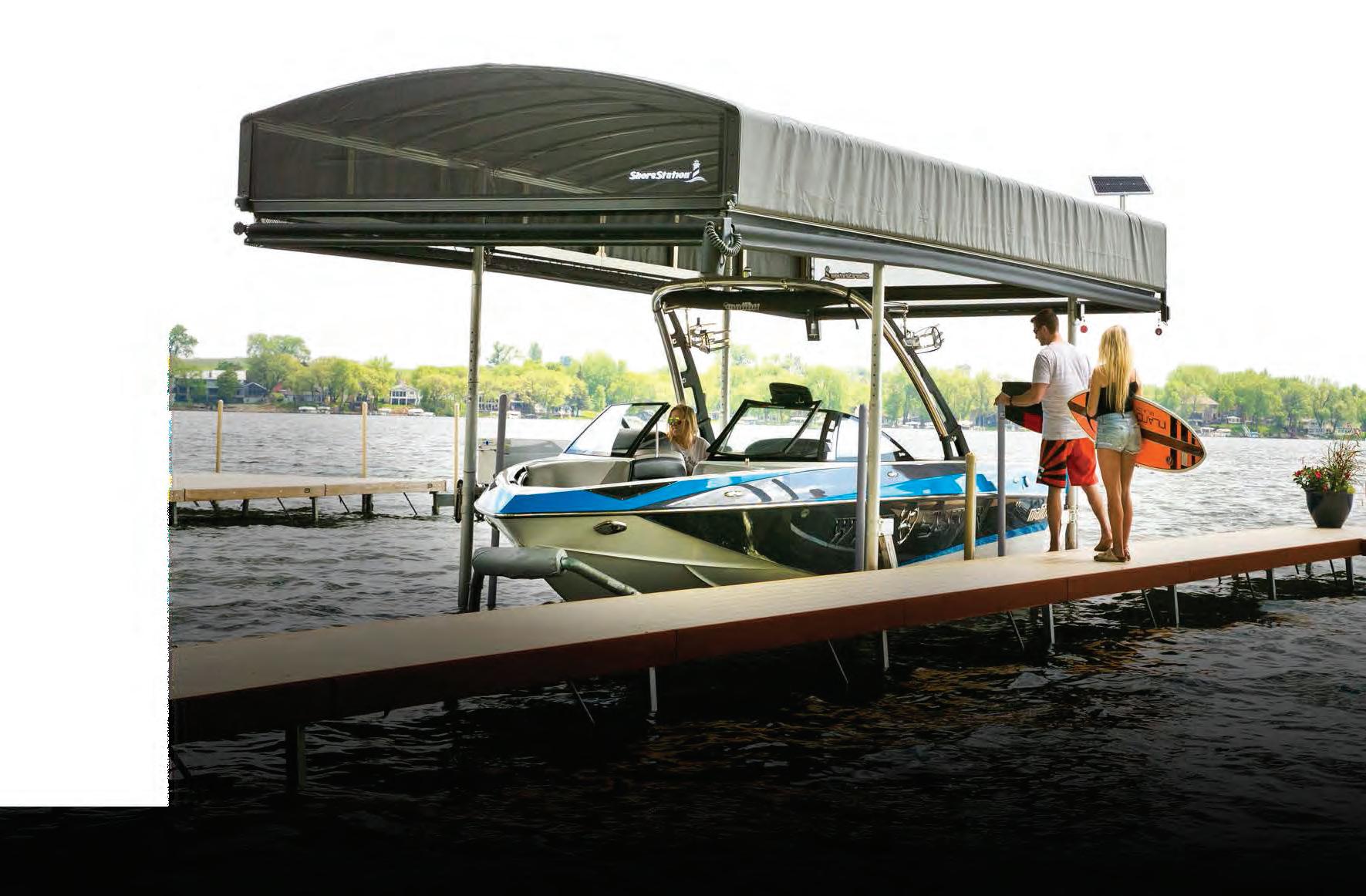

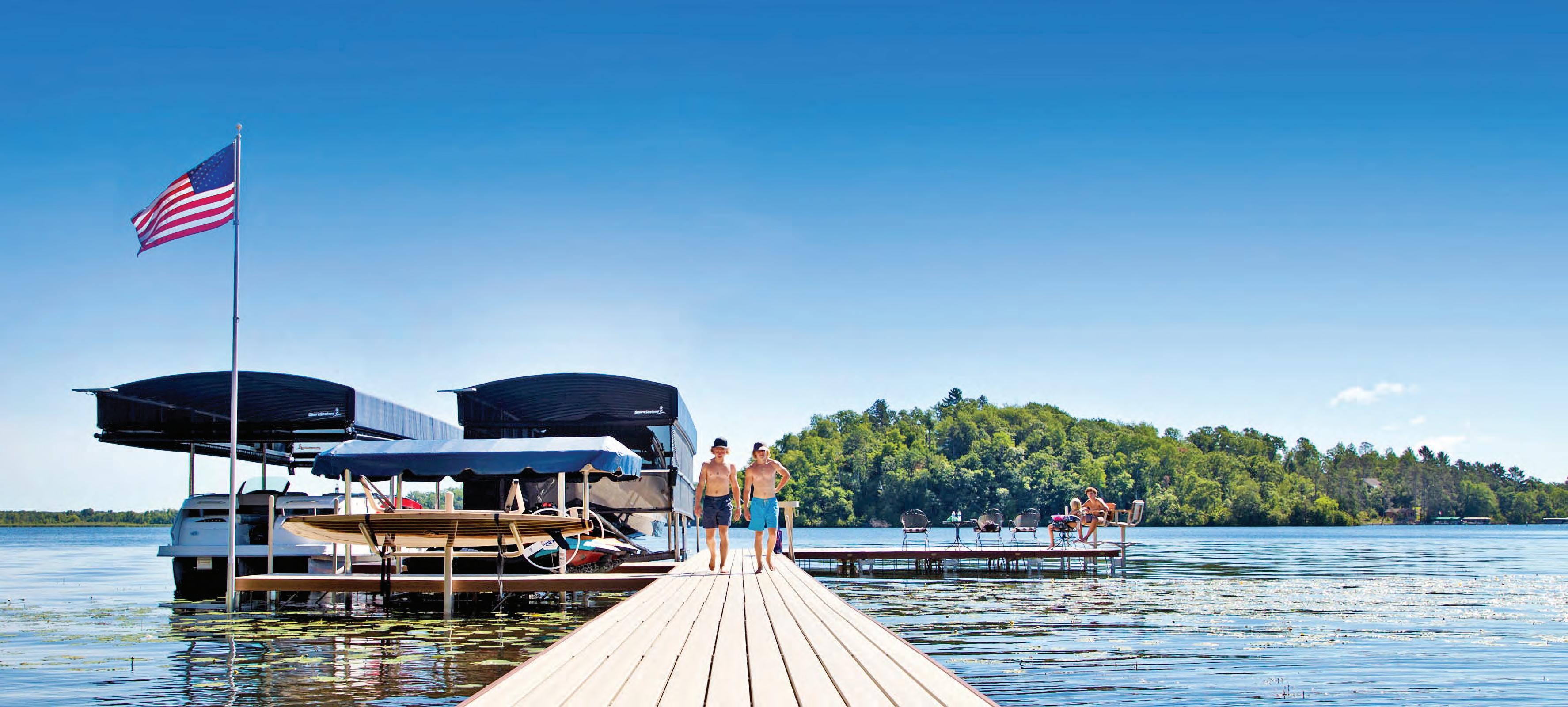



Equipped with exceptional weather resistant fabric and breathable SunTex 80 woven mesh ends for maximum protection and durability, the REVOLUTION™ Series Canopy is the most innovative canopy

Made from the highest quality materials, our innovative hydraulic boat lift is one of the fastest and safest lifts on the market today. When you have a hydraulic lift, there’s no need to worry about wind and waves getting in your way. This lift will give you confdence to safely land and secure your boat in less-than-ideal conditions.

Never miss another moment on the water. Power your lift with clean, free solar power. Our speedy 20 watt charger features solar regulator drainage protection, saving your battery from permanent damage caused by overcharging.




Fishing out of Murrells Inlet on May 23, angler James Carroll battled in a 129-pound amberjack that is a new South Carolina state record. Here is the story in Carroll’s own words:
We set out from Murrells Inlet, S.C. at the crack of dawn, heading ofshore to the Winyah Scarp area, about 60 miles out. Our goal was to catch some mahi or wahoo. Afer a few hours of trolling along a weed line and the ledge without success, we decided to move closer in and try bottom fshing.
We relocated to a spot about 50 miles ofshore in 100 feet of water. I switched to a Connley Fishing kingfsh rod paired with a Penn Fathom 40, rigged with 80-lb. Momoi Diamond Braid and a two-hook bottom setup.
At this location, we caught vermilion snapper, black sea bass, grunts and porgies, sometimes two at a time. It was a productive day. I began waiting afer getting a bite, hoping to hook a second fsh. While doing this, something big hit the line without getting hooked.
Finally, I hooked a monster fsh. Afer about 45 minutes of fghting, I told my great friend and captain of the Liberty Call, Gordon Jobe, to put the boat in gear to help bring the fsh up in the water column. Around the one-hour mark, we landed what turned out to be a South Carolina state record greater amberjack.
Using a Garmin InReach, we contacted friends onshore to check the state record weight for South Carolina. Tey replied with 123 lbs. We knew we had surpassed that mark but had to wait a few hours to confrm.
Back at the dock, we went to Seven Seas Seafood Market in Murrells Inlet, S.C., to weigh the fsh on their certifed scales. Te fsh weighed in at 129 lbs. and measured 69 inches in length. Afer certifcation by Kris Reynolds, of the South Carolina Department of Natural Resources, the crew at Seven Seas processed the fsh for me.
For more giant fsh, go to coastalanglermag.com






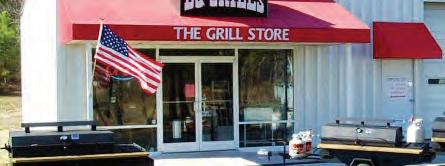












The very best hunting knives possess a perfect balance of form and function. They’re carefully constructed from fine materials, but also have that little something extra to connect the owner with nature. If you’re on the hunt for a knife that combines impeccable craftsmanship with a sense of wonder, the $79 Huntsman Blade is the trophy you’re looking for.
The blade is full tang, meaning it doesn’t stop at the handle but extends to the length of the grip for the ultimate in strength. The blade is made from 420 surgical steel, famed for its sharpness and its resistance to corrosion.
The handle is made from genuine natural bone, and features decorative wood spacers and a hand-carved motif of two overlapping feathers— a reminder for you to respect and connect with the natural world.
This fusion of substance and style can garner a high price tag out in the marketplace. In fact, we found full tang, stainless steel blades with bone handles in excess of $2,000. Well, that won’t cut it around here. We have mastered the hunt for the best deal, and in turn pass the spoils on to our customers.
But we don’t stop there. While supplies last, we’ll include a pair of $99 8x21 power compact binoculars and a genuine leather sheath FREE when you purchase the Huntsman Blade
Your satisfaction is 100% guaranteed. Feel the knife in your hands, wear it on your hip, inspect the impeccable craftsmanship. If you don’t feel like we cut you a fair deal, send it back within 30 days for a complete refund of the item price. Limited Reserves. A deal like this won’t last long. We have only 1120 Huntsman Blades for this ad only. Don’t let this beauty slip through your fingers. Call today!

Huntsman Blade $249* Offer Code Price Only $79 + S&P Save $170
1-800-333-2045
Your Insider Offer Code: HBK237-01
You must use the insider offer code to get our special price.
Stauer® 8x21 Compact Binoculars -a $99 valuewith purchase of Huntsman Blade

What Stauer Clients Are Saying About Our Knives
“This knife is beautiful!”
— J., La Crescent, MN
“The feel of this knife is unbelievable...this is an incredibly fine instrument.”
— H., Arvada, CO

Rating of A+
14091 Southcross Drive W., Dept. HBK237-01 Burnsville, Minnesota 55337 www.stauer.com
*Discount is only for customers who use the offer code versus the listed original Stauer.com price.
California residents please call 1-800-333-2045 regarding Proposition 65 regulations before purchasing this product.
• 12” overall length; 6 1/2” stainless steel full tang blade • Genuine bone handle with brass hand guard & bolsters • Includes genuine leather sheath


